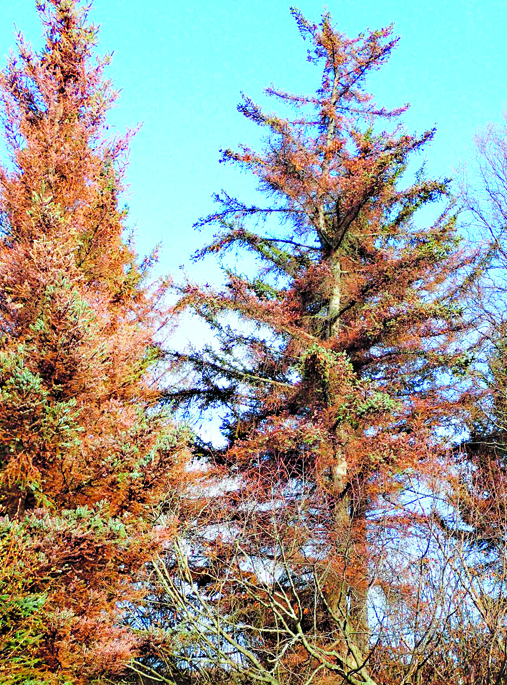Last spring, homeowners near Halibut Cove and Homer began to see needles on their spruces turning yellow and brown.
Naturalists from the Alaska Division of Forestry, the Kenai Wildlife Refuge, and the University of Alaska’s Cooperative Extension Service examined the trees on trips in June 2015 and late March of this year.
Kenai National Wildlife Refuge entomologist Matt Bowser said DNA tests completed this week confirmed that the insects responsible are European spruce aphids — an invasive species having its first outbreaks on the Kenai Peninsula.
Originally from Europe, spruce aphids have existed in the Pacific Northwest since the 1910s, and have been sucking sap from the needles of Sitka spruce in southwest Alaska since the 1960s, according to the U.S. Forest Service’s 2015 Forest Health Report. Bowser said the aphids recently found around Kachemak Bay likely came from the Prince William Sound area. Spruce aphids are born in winged and unwinged types, but even flightless individuals are light enough to be carried by the wind, allowing aphid populations to expand to new territory. However, other factors may account for the unprecedented size of this year’s Homer-area aphid population.
“If they’re in Prince William Sound, we’d expect that some of these (aphids) would end up on the western Kenai,” Bowser said. “They probably have been for a while. What’s different now is that we have conditions that have allowed them to reach outbreak levels. … There have been very small numbers of them here and there, but they’ve never been able to really take off until we had these runs of warm winters, which is what they need.”
U.S. Forest Service Entomologist John Lundquist said temperatures can be responsible for aphid outbreaks and die-offs.
“Their populations usually increase in early spring or late winter,” Lundquist said. “That’s when a lot of the damage occurs. … Usually in winter, their populations are knocked down. If we have a nice cold snap, their populations are going to plummet. But this winter’s been so mild that these guys have been able to survive and they actually reproduce through the winter. And that’s why the populations seem to be pretty high, and that’s why it’s been so visible.”
Temperature-sensitivity also means the aphids are likely to be confined to coastal areas, as they are in the southeast, and may also limit their future spread. Bowser said that in March naturalists had failed to find spruce aphids in Anchor Point, Kenai, Cooper Landing and Hope.
Unlike the spruce bark beetles that destroyed about 3.5 million acres of Sitka spruce on the Kenai Peninsula in the 1990s, aphids are more likely to disfigure than kill their host trees. While the beetles feed on sap-circulating material beneath the tree’s bark, aphids suck the needles dry, leaving the tree wounded but alive.
However, an aphid attack may make a tree more vulnerable to other pests. Bowser and Lundquist said it’s too early to predict precisely how the aphids will interact with existing spruce predators such as bark beetles, but that they will likely make trees more open to attack.
In addition to temperature, Lundquist said aphid population cycles are also tied to a tree’s abundance of mature needles, which provide the best food for aphids. After killing most of a tree’s mature needles during their winter-end population burst, the aphids’ activity will decline until the end of summer, when younger needles have matured into a fresh food source. Thus the aphids are likely to have a second population increase in the fall.
For homeowners defending against spruce aphids, early detection is important. According to an information sheet from the University of Alaska’s Cooperative Extension Service, needle damage doesn’t become visible until months after it has occurred.
Jessie Moan, a pest management technician with the University of Alaska’s Cooperative Extension Service, gave a low-tech way to manage an aphid infestation.
“You can do things as simple as spraying aphids out of the tree with a jet of water,” Moan said. “… It won’t kill the aphids, but it will knock them out of the tree and therefore reduce damage. Also, when they’re off the tree, they’re more vulnerable to predation and desiccation and things like that.”
Ben Boettger is a reporter for the Peninsula Clarion.



